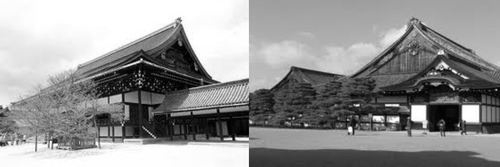Differences Between the Way the Shogun Ruled and the Way the Emperor Ruled
The Kyoto Gosho of the Imperial family was simple and elegant while strict and restrained at the same time. The Kyoto Gosho had no extraordinary adornments or decorations to impress visitors. Instead the places that were of great significant value were the areas where religious ceremonies were held. The entire structure seems to be very connected with nature and its elements with the way the ceilings and the verandas were open allowing access outside.
As an Emperor, his right to rule was not something given and neither could it be taken away from him. He has the right to rule because he was the direct descendant of the Sun goddess, Amaterasu. It was through this irrefutable connection with nature and the heavens that the Emperor legitimizes his role, interacted with the people and maintained his rule. He was of great religious importance to the people and through this concept, the Emperor and the Imperial family had no reason to impress others because their wealth was in their blood. It is because the Emperor’s right to rule was something unquestionable that the Emperor was often closed off from the public. During the Pre-modern times when Emperors were central authoritative figures, they had little contact with the people and vice versa. He was a demi-god that ruled because of religion, interacted with people and maintained power through religion.
The Ninomaru Palace, however, is far more complex than the Kyoto Gosho in terms of layout and purpose. Its numerous adornments and embellishments established the Shogun's need to display his wealth and status to all who visited him. The palace was built with the intention to awe and intimidate something which the Emperor had no reason to do. The idea that guests had to be constantly reminded of the Shogun’s power implied that the Shogun had to be always constant and alert. The position of a Shogun was not as stable or permanent as that of the Emperor’s. The Shogun’s rule and authority comes from their ability to utilize their wealth and influence to get what they want.
While the Emperor's right to rule derived from his ancestry, the Shogun's right to rule derived from the Emperor’s acknowledgment. The role of a shogun was an easily substituted position and so the Shogun would use intimidation and magnificent displays of wealth and power to rule ensuring that everyone either fear or respected. It was only then can they remain indispensable and safeguard their authoritative position.
